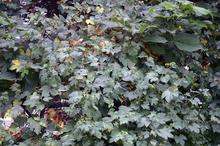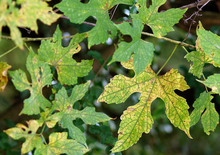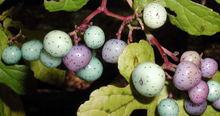Quick facts
Porcelain berry is an invasive species.
- Porcelain berry grows well in a variety of soil types, but is not tolerant of heavily shaded areas.
- It grows in thick monocultures, shading out native vegetation.
Porcelain berry should be reported. The Minnesota Department of Natural Resources provides detailed recommendations for reporting invasive species.
How to identify porcelain berry
- Porcelain berry (Ampelopsis brevipedunculata) is a perennial, woody vine climbs by tendrils and can grow to 15–20 feet.
Stems
- The pith of stem is white in color.
- The bark has small lenticels that look like spots.
Leaves
- Leaf shape can vary but often are deeply lobed with three to five divisions.
- Often grape-like in shape and appearance.
- Leaves are alternate, simple and heart shaped, with fine hairs on the underside of the leaf.
Flowers
- Greenish-white or greenish-yellow flowers held upright in an umbrella-like shape.
- Blooms from June to August in flat-topped clusters.
Fruit
- Small berries that range from yellow to purple to blue in color.
Seeds
- Each berry holds two to four seeds that are moved by birds.
Roots
- Extensive root system.
- Vegetative growth is possible as new plants can resprout from cut roots.
Reviewed in 2019




